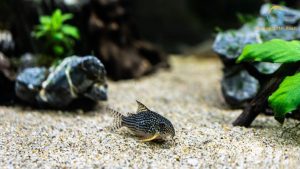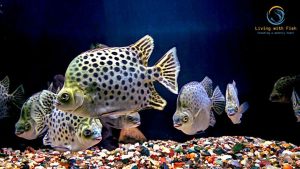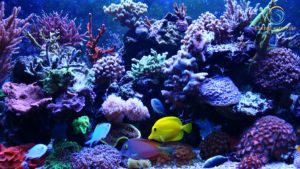This article covers the following areas –
Setting up an aquarium at home can be exciting and rewarding, but choosing the right fish for beginners can be daunting. For the novice aquarist, it’s essential to choose fish species that are hardy, low-maintenance, and compatible with other species. In this post, I’ll guide you through the top species that are perfect for a new aquarium.
Ideal beginner-friendly fish species for a new aquarium include Guppies, Betta Fish, Platies, Zebra Danios, and Swordtails. These species are selected for their hardiness, low maintenance needs, and peaceful temperament, which are beneficial traits for novice aquarists.
For a deeper understanding of these species, including detailed information about their care, feeding requirements, and compatibility with other species, continue reading. This post provides invaluable insights that can help novices start their aquarium journey on the right foot.
Key Factors for Beginner-friendly Fish Species

Building a thriving aquarium doesn’t happen by chance. It involves careful selection of fish species based on a few key factors. Here’s an overview of the essential attributes to consider when choosing beginner-friendly fish species.
1. Hardiness
In the context of fish, hardiness refers to a species’ resilience or its ability to withstand changes in water conditions, such as temperature or pH fluctuations. This trait is particularly important for beginners who might face challenges in maintaining the perfect water balance, particularly in the initial days of setting up their aquarium.
Hardy fish species are adaptable and can survive even if the water parameters are not perfectly consistent or ideal. They are less likely to fall ill under fluctuating conditions, giving you more leeway to learn the ropes of maintaining a stable aquarium environment.
2. Low Maintenance
Another important aspect to consider is how much care the fish species require, especially regarding feeding and tank cleanliness. As a beginner, you’ll benefit from choosing fish species that are not too demanding in terms of their diet and cleanliness requirements.
The diet of fish varies from one species to another. Some fish are carnivorous, others are herbivorous, and many are omnivorous. Beginners should look for fish that are not overly fussy about their food. Fish that can thrive on commercially available flake or pellet foods, and do not require frequent feeding, are generally a good option.
Some fish produce more waste than others, contributing to the buildup of toxins in the tank, which can lead to more frequent cleaning. Therefore, fish species that produce less waste can be easier to care for, making them ideal for beginners.
3. Compatibility
Aquarium compatibility is another crucial factor to consider, especially if you plan to host multiple species in your tank. While some fish are docile and get along well with others, some are territorial or predatory.
Peaceful fish species are sociable and can coexist with a variety of other species without issues. On the other hand, aggressive fish may fight or even harm other fish, especially those of the same species or smaller, less assertive species.
A good example of a compatible fish species is the guppy, which is peaceful and can happily coexist with many other species. Conversely, the Betta fish, known for its vibrant beauty, is often aggressive towards other Bettas and similarly shaped fish and thus should be kept alone or very carefully with others.
By understanding hardiness, maintenance, and compatibility factors, you can take a confident step towards creating your beginner-friendly aquarium with a harmonious and healthy fish community. The next section will detail some of the best fish species for beginners, taking into consideration these key attributes.
Top Beginner-friendly Fish Species
Now that we have a deeper understanding of the key factors that make certain fish species more beginner-friendly let’s delve into specific species that embody these traits. We will explore each species’ unique features, care and feeding requirements, and compatibility with other species.
These species were chosen due to their hardiness, low maintenance needs, and peaceful demeanor, making them ideal candidates for your first foray into aquatics.
1. Guppies (Poecilia reticulata)

Guppies are small, vibrant, and resilient fish that have earned a reputation as a perfect starting point for novice aquarists. Their hardy nature, easy care requirements, and peaceful temperament make them a delight to own and observe.
Overview
Native to South America, Guppies are a highly adaptable species known for their bright, multicolored patterns and swift, darting movements. Their small size makes them suitable for tanks of different sizes, from small desktop aquariums to large community tanks. With their myriad color combinations, Guppies add a burst of color and liveliness to any aquarium setup.
Care and Feeding
Guppies are omnivores, meaning they eat a mix of plant-based and meat-based foods. High-quality flake food available at most pet stores can easily meet their dietary requirements. Supplementing their diet with occasional live or frozen treats like brine shrimp or bloodworms will keep them healthy and their colors vibrant. It’s crucial to avoid overfeeding, as this can lead to water quality issues.
Compatibility
Guppies are a peaceful species, making them an excellent choice for a community tank. They coexist well with other non-aggressive species like Tetras, Platies, and Mollies. Avoid pairing them with larger, aggressive species that might see Guppies as food.
2. Betta Fish (Betta splendens)

Betta Fish, with their vibrant colors and majestic, flowing fins, are a favorite among aquarists. However, they require a bit more care than Guppies and have unique compatibility considerations due to their territorial nature.
Overview
Betta Fish, often referred to as “Siamese Fighting Fish,” are native to Southeast Asia. They are best known for their dazzling array of colors and large, flowing fins. Bettas can live in small tanks, making them ideal for those with limited space.
Care and Feeding
As carnivorous fish, Betta fish thrive on a diet rich in protein. High-quality Betta-specific pellets or flakes should be the mainstay of their diet, supplemented occasionally with live or frozen foods like bloodworms or brine shrimp. Unlike Guppies, Bettas can be prone to overeating, so feeding them a measured amount once or twice a day is recommended.
Compatibility
Bettas are known for their territorial nature, particularly males of the species. They are best kept alone or in a large tank with non-aggressive, dissimilar-looking fish. Male Bettas should never be kept together, as they will fight, often to the death.
3. Platies (Xiphophorus maculatus)

Platies, with their hardy nature, lively demeanor, and brightly colored bodies, make an excellent addition to a beginner’s tank.
Overview
Platies are small, brightly colored fish native to Central and South America. They come in various colors, including red, yellow, and orange, often with interesting patterns. Their resilience and adaptability make them a stress-free choice for beginners.
Care and Feeding
Being omnivores, Platies thrive on a varied diet that includes both plant and animal matter. High-quality flake food, supplemented with vegetable matter and occasional live or frozen treats, makes for a balanced diet. Platies tend to graze throughout the day, so small, frequent feedings are preferable to one large daily feeding.
Compatibility
Platies are sociable and peaceful, making them an excellent choice for community tanks. They get along well with other peaceful species such as Guppies, Tetras, and other livebearers.
With this understanding of beginner-friendly fish species and their specific needs, you are now better equipped to start your aquatic journey. Choose the species that best fit your interest, tank setup, and ability to meet their care needs. Remember, every species is unique, and part of the joy of fishkeeping is learning about and catering to their unique behaviors and requirements.
4. Zebra Danios (Danio rerio)

Among the most resilient and adaptable species, Zebra Danios are an excellent choice for beginners venturing into the aquarium hobby. Their eye-catching stripes, playful demeanor, and minimal care requirements make them an attractive addition to any fish tank.
Overview
Zebra Danios are small, agile fish from the tropical regions of South Asia. They sport a distinctive pattern of alternating blue and silver stripes, reminiscent of a zebra’s coat, lending them their common name. One of the most appealing attributes of Zebra Danios is their hardiness.
These robust swimmers can tolerate a broad spectrum of water conditions, providing a substantial margin of error for novice aquarists still honing their water maintenance skills.
Care and Feeding
Zebra Danios are omnivorous, signifying their dietary requirements encompass plant- and meat-based nutrients. A diet composed of high-quality flake or pellet food forms the base of their nutrition.
However, it is beneficial to supplement this with live or frozen treats such as daphnia, brine shrimp, or bloodworms. This varied diet will ensure they receive all the essential nutrients, resulting in healthier fish displaying vibrant colors.
Compatibility
Zebra Danios exhibit schooling behavior in nature, and they retain this preference in captivity. A group of five or more will often be seen swimming in unison, creating an impressive spectacle. Their peaceful nature makes them compatible with most other non-aggressive species in a community tank setup.
One word of caution: their active swimming might occasionally lead to fin nipping. As such, they may not be the best companions for slow-moving or long-finned species.
5. Swordtails (Xiphophorus hellerii)

Swordtails are a rewarding addition to any beginner’s aquarium. Their hardiness, straightforward care requirements, and unique, sword-like tail appeal to both novice and seasoned aquarists alike.
Overview
Swordtails are fascinating freshwater species indigenous to North and Central America. Their name derives from the elongated lower part of the male’s tail fin, which resembles a sword. This feature, combined with their vibrant green, red, or yellow bodies, makes them a visually enchanting addition to an aquarium.
Care and Feeding
Like many beginner-friendly species, Swordtails are omnivorous, requiring a balanced plant and animal matter diet. Staple high-quality flake food suffices for their daily meals, but enhancing their diet with occasional fresh greens and live or frozen foods is advisable. This variety meets their nutritional needs and mimics the diverse diet they would consume in the wild, contributing to their overall well-being.
Compatibility
Swordtails typically display a peaceful demeanor, making them a solid choice for community aquariums housing non-aggressive species. However, male Swordtails can sometimes exhibit territorial behavior toward other males, especially in the breeding season.
A balanced ratio of males to females is recommended to ensure a harmonious environment. This approach helps disperse any aggression and allows for a more tranquil tank.
In Conclusion
Choosing the right fish for your new aquarium can seem challenging, but it can be a smooth journey if you opt for hardy, low-maintenance, and compatible species like Guppies, Betta fish, and Platies.
Remember, the key is to research each species thoroughly to ensure that they are suitable for your specific situation and that you can provide the appropriate care. With patience and diligence, you’ll create a beautiful aquatic environment that you can enjoy for years to come.






